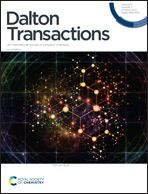Dehydrogenation of formic acid using iridium-NSi species as catalyst precursors†
Abstract
Using a low loading of the iridium(III) complexes [Ir(CF3SO3)(κ2-NSiiPr)2] (1) (NSiiPr = (4-methylpyridin-2-yloxy)diisopropylsilyl) and [{Ir(κ2-NSiMe)2}2(μ-CF3SO3)2] (2) (NSiMe = (4-methylpyridin-2-yloxy)dimethylsilyl) in the presence of Et3N, it has been possible to achieve the solventless selective dehydrogenation of formic acid. The best catalytic performance (TOF5 min ≈ 2900 h−1) has been achieved with 2 (0.1 mol%) and Et3N (40 mol% to FA) at 373 K. Kinetic studies at variable temperatures show that the activation energy of the 2-catalyzed process at 353 K is 22.8 ± 0.8 kcal mol−1. KIE values of 1.33, 2.86, and 3.33 were obtained for the 2-catalyzed dehydrogenation of HCOOD, DCOOH, and DCOOD, respectively, in the presence of 10 mol% of Et3N at 353 K. These data show that the activation of the C–H bond of FA is the rate-determining step of the process. A DFT mechanistic study for the catalytic cycle involving hydride abstraction from the formate anion by the metal, assisted by a molecule of formic acid, and heterolytic H2 formation has been performed. Moreover, the presence of Ir-formate intermediates was identified by means of NMR studies of the catalytic reactions in thf-d8 at 323 K. In all the cases, the decomposition of the catalyst to give unactive crystalline iridium NPs was observed.



 Please wait while we load your content...
Please wait while we load your content...